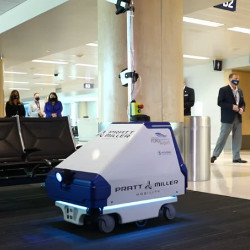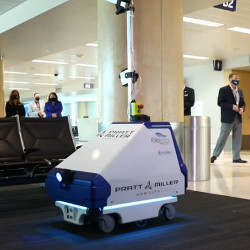
The impacts of the COVID-19 pandemic are likely to be felt for years to come, regardless of the presence and availability of a vaccine. Physical measures adopted by humans, such as social distancing or wearing masks, are likely to be utilized for years to come, along with technological developments deployed in both public and private spaces that are focused on enforcing social distancing, enabling more efficient cleaning and disinfecting of spaces, and driving more automation and intelligence to reduce humans’ direct physical interaction with each other.
Some companies and individuals feel the best way to avoid COVID-19 or other viruses is to simply avoid all unnecessary human contact. As such, many companies have introduced or fast-tracked the use of automation to lessen their reliance on human workers, as well as to enhance their responsiveness to customer queries.
For example, beginning last fall, the White Castle burger chain planned to test Flippy, a robot arm that can cook French fries and other foods. Made by Miso Robotics, Flippy can free up employees for other tasks, like disinfecting tables or addressing delivery orders, while reinforcing a touch-free environment during food preparation, important to people concerned about the spread of germs. Miso says Flippy currently costs $30,000, plus a $1,500 monthly service fee, but the company expects to shift to a different business model by the middle of this year. This new model charges users a higher monthly service fee in lieu of an up-front charge for the robot.
Other companies also have rolled out food-preparation robots during the pandemic, such as Hayward, CA-based Chowbotics, which has deployed Sally, a robot about the size of a refrigerator that can make up to 65 bowls of salads before needing to be refilled. The company says it has been deployed at grocery stores, hospitals, and college campuses, such as Big Y Supermarket, University of Arkansas for Medical Sciences, and Elmira College, among others. Similarly, Blendid, a Silicon Valley startup, sells a robotic kiosk that can make fresh smoothies without human intervention, guided by a smartphone app that allows users to customize their drinks. These kiosks are currently in use at the University of San Francisco Market Café, at Charlie Brown’s Café at Sonoma State University, and at Plug and Play, a tech center in Sunnyvale, CA.

Figure. A robot at the Blendid kiosk on the University of San Francisco campus pours a smoothie it just made into a cup. The robot, which takes the place of a human employee, is capable of making up to 45 smoothies per hour.
Despite the increasing use of robots and automation, avoiding all human contact is impossible, particularly in the retail environment. Retail spaces—and other public spaces—are among the most challenging environments to keep clean under normal circumstances, given the large number and variety of people and objects within the space, the extensive surface area on which the virus could settle, and the tendency of humans to touch objects indiscriminately. Two primary approaches are being utilized to help keep customers safe.
The first is by implementing technology to help address social distancing measures, by tracking not only how many people are inside a store at a given point of time, but also to help ensure they are not bunching up or crowding together. For example, Pune, India-based technology company Glimpse Analytics refocused its artificial intelligence-based analytics device to help alert retail stores or offices to violations of occupancy limits, or situations where social distancing or personal protective equipment (PPE) mandates such as mask wearing are not being observed.
According to Kakshil Shah, one of Glimpse Analytics co-founders, the technology uses a store’s existing CCTV cameras to capture images that are analyzed on “edge,” or local, devices, using machine learning to assess a number of demographic or behavioral indicators about shoppers, including the number of shoppers within the store at any given time, the size and amount of time spent waiting in line, in-store traffic patterns and heat maps, as well as basic demographic data such as ethnicity, age, and gender. Because the data is processed by Glimpse Analytics on a standalone edge device within the store, no data is sent back to a central processor offsite, or stored in perpetuity by the vendor.
“There are two primary features that are actively used,” Shah says. “One is tracking how many people are actually inside of a store or a mall. The other thing we are seeing being used is for [monitoring] queues,” either within stores or in malls, which helps provide insight to shopping center operators who want to see where people are bunching together, and identify which stores or areas within a store are most popular. Shah also notes that some retailers are using the computer vision technology to determine whether customers are wearing a face covering, and if they are wearing it properly.
The purpose of the system is to capture data on how and where people are congregating, or whether they are not adhering to health protocols. Rather than being used to call out individuals for non-compliance, the data is extracted so the store can implement policy or tactical changes to improve social distancing or address staffing issues to help enforce mask wearing. Glimpse says it is working with a number of brands in India (Future Group, Samarth Mart, and The Souled Store), in Kuwait (Synergy United Co.), in London (at several malls and the London Underground,), and in a business park in the U.S.
Still, many people are still wary of entering indoor spaces, particularly elderly and immune-compromised individuals. As such, many companies have expanded curbside delivery and pickup options, which are designed to allow people to avoid crowds and lines in the stores, as well as limiting their interactions with store staff. The challenge for many retailers lies in managing a curb-side pickup program, particularly if they share curbsides and parking spaces with other retailers that also may be offering curbside pickup.
RE Insight, an Irvine, CA-based technology company that provides hardware and software solutions to retail store owners and operators such as shopping malls and shopping centers, offers vQueue+, a hardware and software platform that allows properties to track and analyze visitor counts, manage and encourage social distancing protocols, and communicate with shopping center visitors to manage reservations, pick-up orders, or handle virtual queueing quickly and efficiently. This text-based solution is designed to interface with each individual store’s customer management solution, allowing visitors to create reservations for merchandise pickup, monitor their position in a queue, and receive update notifications on a mobile device via text.
Within a shopping center or mall, all of the disparate retailers are able to offer curbside pickup, and have it coordinated and managed through a single, common platform, reducing competition and confusion among retailers while ensuring better customer service. Most importantly, customers can book pickup reservations at multiple stores within the shopping center, and the platform will route them to the appropriate pickup area, taking into account pick-up queues and traffic.
“The challenge operators have is that people want to pick up at different stores,” says Quinn Munton, president and CEO of RE Insight. “Lowe’s is doing it differently than Best Buy, and Ulta [Beauty] wants to do it differently than PetSmart. They all want the prime parking spots blocked off, they want to use their own signage, and they don’t have any way to communicate with [customers.] And so, we’ve seen a lot of early disasters with owner-operators where they rolled something out and then it failed because they didn’t have a communication tool. So we built a platform that will integrate with apps, and will integrate with their Web portal so that they can make it a seamless experience from beginning to end.”
As life continues to return to normal, retailers and other spaces that are used by the public have been forced by COVID-19 to deploy more frequent and robust cleaning measures. One way to handle this task more efficiently than hand-wiping every item, shelf, or surface in the space is by using automated robots to spray disinfectant that can kill viruses or other pathogens. An example of the technology comes from Pratt Miller Mobility (PMM), which has deployed its Autonomous Disinfecting (LAAD) vehicle at the Gerald R. Ford International Airport in Grand Rapids, MI. As part of a grant from the Michigan Economic Development Corporation (MEDC) and PlanetM, the state’s mobility initiative, the LAAD was deployed in July 2020 to demonstrate how large public areas could be efficiently and reliably disinfected.
Using a combination of computer vision technology and LiDAR (light detection and ranging), the connected, autonomous LAAD vehicle can navigate autonomously throughout public spaces, delivering a measured amount of FDA-approved disinfectant through a multi-head electrostatic sprayer array far more efficiently and reliably than humans could. Through the use of sensors and data analysis, the autonomous platform monitors and guarantees delivery of the disinfectant and, depending upon the size of tank used to store disinfectant, can cover areas the size of airport terminals, arenas, or shopping malls.
“In its current configuration, LAAD holds seven gallons of solution, which is ideal for long runs like airport terminals,” says Chris Andrews, Pratt Miller Director of Mobility and Innovation. “It not only alleviates having to refill the tank, but it monitors, documents, and reports on what was covered.”
Andrews also highlights the LAAD’s flexibility. “The modularity of the platform allows users to customize the system for their individual needs,” he says. “If you need more or less solution and coverage, we can configure the platform for the application.”
Andrews said the LAAD would be further evaluated and refined, and expected to make deployment announcements late last year, anticipating rollouts to big-box retailers, sports stadiums and arenas, and shopping malls.
Other disinfecting solutions are focused on using UV-C, a type of ultraviolet light, on a more targeted basis, particularly when dealing with objects likely to be touched by the public, such as menus, keypads, pens, or other small items. Vioguard’s Cubby Plus uses UV-C light contained within a drawer-like case that can be used to target coronavirus, along with a host of other bacteria and viruses. The level of UV-C light required kill viruses and bacteria is potentially harmful to humans if they look directly at the source, so a contained solution works better for high-traffic areas, such as retail and restaurants.
Other disinfecting solutions focus on using UV-C, a type of ultraviolet light, on a more targeted basis, particularly when dealing with objects likely to be touched by the public.
The Cubby Plus cabinet solution is particularly useful for items that are frequently handled by staff and customers, such as credit card holders at restaurants, pens, and even small merchandise items such as jewelry that need to be disinfected regularly.
“I sat down at a restaurant and the waiter came and put a laminated menu on the table,” recalls Mark Beeston, VP of sales and marketing for Vioguard. “And I thought that, ‘you know, are these menus getting cleaned or are they just being collected and then stacked back in the back?’ So a laminated menu or a paper menu could be run through the Cubby Plus and disinfected.”
Cadnum, Jennifer, et al.
Evaluation of an electrostatic spray disinfectant technology for rapid decontamination of portable equipment and large open areas in the era of SARS-CoV-2. Am J Infect Control. 2020 Aug; 48(8): 951-954. https://www.ncbi.nlm.nih.gov/pmc/articles/PMC7275188/
Large Area Autonomous Disinfecting Vehicle information site, Pratt & Miller, https://www.prattmiller.com/laad
Miso Robotics – Meet Flippy, https://www.youtube.com/watch?v=ylO-OgRpobo





Join the Discussion (0)
Become a Member or Sign In to Post a Comment